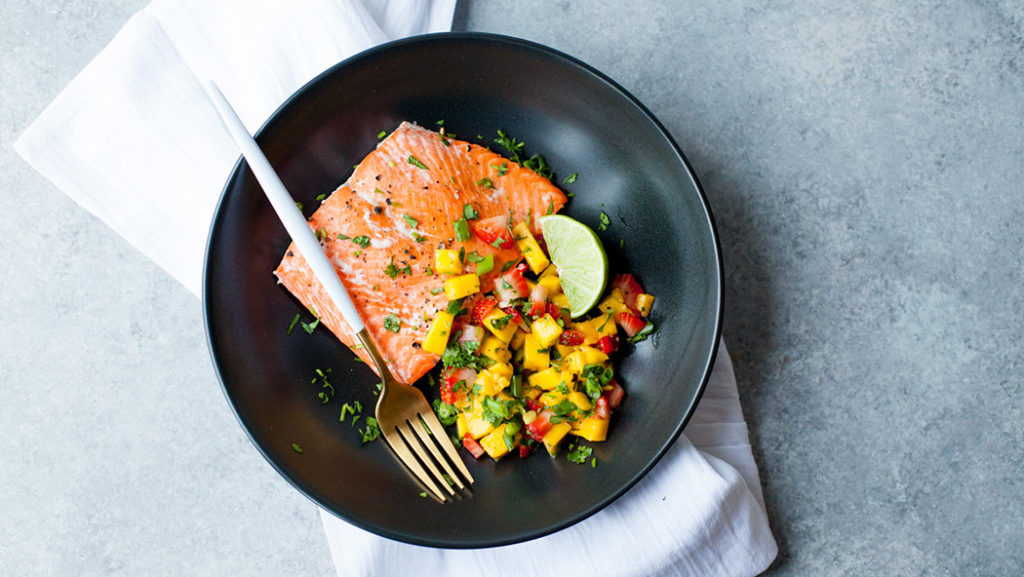One of the best ways to keep your heart as healthy as possible is by sticking to a diet packed with healthy fats (there are many!) and antioxidants like those found in this super easy Roasted Salmon with Strawberry Mango Salsa recipe. But before you head to the supermarket with your ingredient list, let’s be sure you understand how to whip up a balanced heart-healthy lifestyle.
Our Favorite Ways to Make Your Ticker Happy
Exercise
We might be biased but this is one of our favorites. According to the American Heart Association, adults should get “at least 150 minutes per week of moderate-intensity cardio or 75 minutes of vigorous aerobic activity spread throughout the week.” Throw in some moderate to high-intensity muscle-strengthening (like resistance or weight training) at least two of those days and spend less time sitting!
Stress Reduction
We looked to the Myocarditis Foundation on this one to learn that when we’re stressed we release hormones, such as adrenaline and cortisol, that increase our heart rate. Extended periods of stress keeps these levels high for a prolonged period, which can lead to high blood pressure and inflammation. That said, regular meditation can reduce cortisol or simply by doing things you love and doing them more often!
Sleep
We’re finally opening our eyes to the absolute necessity of shuteye. The CDC wants you to know that adults who sleep less than 7 hours each night are at greater risk for heart attack, heart disease, and stroke. Unhealthy sleep can also lead to Type 2 Diabetes and obesity, so hit the sack, friends, and if you have a condition like insomnia or apnea, consult with your health care professional.
Food
Time to eat! A heart-healthy diet is more accessible than you might know, easy to prepare, and as delicious as they come. According to Chris Kresser, an expert in Functional Medicine and New York Times-bestselling author, cold-water, fatty fish is an excellent source of omega-3 fats with many cardiovascular benefits, like salmon. And antioxidant-rich foods are heart-protective in lots of ways, too. Here you have a plethora of choices, especially when it comes to fruits and vegetables. A good rule of thumb, Kresser says is to choose a variety of colors. (Like deep red strawberries or bright yellow Champagne mangos, loaded with Vitamin C.)
Which brings us to our incredibly delectable recipe. Is your heart pounding with excitement? Or are you afraid to cook fish? Lots of people are but nothing could be easier than preparing a filet of roasted salmon. So cool your jets. Remember, stress less. And check this out:
Depending on the thickness of your fish, this dinner can be done, start to finish, in as little as 15 minutes. Add a side of quinoa cooked in veggie broth to fill out the meal and get a nice dose of healthy fiber (also great for heart health), and you’ve got a winner-dinner.
This salmon is paired up with a fruity Mango-Strawberry Salsa, so if you’re salmon-averse, serving it up with a tangy accompaniment might just be the ticket to getting the Omega-3 packed fish on your menu regularly. The sweetness of the salsa is the perfect complement to the savory salmon. But before we dig in, we think it’s wise to share a little science.
The Dish on Fish
For the best heart-health impact, make sure to take a close look at the kind of fresh salmon (or any fish) you buy. When we thoughtfully source our food from those who thoughtfully source theirs, the food supply just keeps improving, and so does our health, heart and otherwise.
So, how do we catch the best fish at our supermarkets? Let’s check out the difference between wild and farm raised fish.
Farm Raised
While eating fish can be very healthy, especially for your heart, some farmed salmon has a tendency to be fattier (and not with good Omega-3 fatty acids) and is often linked to unsustainable farming practices. Farmed salmon typically contains high levels of PCBs from the fish meal they’re fed and when raised in a non-organic way are higher in contaminants. This is not to say there aren’t healthier versions of farm raised salmon on the market, but finding them can prove a daunting task. However, if you do enough homework and ask enough questions, you’re more likely to be successful in your search.
Wild Caught
This kind of fresh salmon tends to be healthier right off the boat, and poses a much lower risk than most farm raised varieties. Wild salmon like Alaskan, Sockeye, Soho, Pink, Chinook, (or King Salmon) Kodiak, and Coho are some of the best varieties to choose. And while wild salmon can be pricier, it also tends to provides a bigger nutritional punch. Many supermarkets carry wild salmon in fresh filets and frozen packages (which are often more affordable).
You can read more about the health and environmental impact of the fish you buy and eat through the Monterey Bay Aquarium Seafood Watch.
And now, the moment you’ve been waiting for, our deliciously easy salmon recipe!
Easy Roasted Salmon with Strawberry-Mango Salsa
Ingredients
2
4-ounce wild-caught salmon filets
1
ripe mango, diced
1/2
cup diced fresh strawberries
2
green onions, sliced
1/4
cup chopped fresh cilantro
salt and pepper, to taste
juice of 1/2 lime
Steps
- Preheat oven to 400 degrees F. Line a small baking sheet with parchment paper and place the room temperature salmon filets skin-side-down onto the parchment. (If the salmon is too cold or frozen, it will cook unevenly, so room temperature is key.) Season with salt and pepper.
- Bake salmon in preheated oven for 10-12 minutes for a filet under 1″ thick. You’ll want to start checking for doneness around the 10-minute mark (overcooked salmon = not good). You’ll know it’s been in the oven for the appropriate amount of cook time when the salmon looks opaque and flakes easily with a fork, so it’s more about look than cook time, really. But if you have a meat thermometer, you’ll want the internal temperature at about 145 degrees F, and since salmon continues to cook after it’s pulled out of the oven, we recommend doing that when it reaches an internal temperature of 140 degrees F.
- While the salmon is roasting, combine the diced mango, strawberries, green onions, cilantro, lime juice, and salt and pepper to taste in a medium-size mixing bowl. Toss to combine. Set aside and serve at room temperature when the salmon is ready.
- Serve salmon hot with salsa on the side. Garnish it with additional lime wedges and chopped cilantro, if desired.
Notes and Substitutions
There are too many great salmon recipes to name, so for people who may want to prepare it in a way other than our featured recipe, or for those who have dietary restrictions, we put our brains together to come up with a flavor parade of other good choices that are also heart healthy dishes. So, get ready to snap some Instagram-worthy pics of your delish fish.
- Use the leftovers or make a couple extra servings for great fish tacos. Add a side of tortilla chips and you’ve got a family pleaser. (Because tortilla chips (and tacos) make everything better.) Great for parties, especially if your guests are vegetarian.
- You can swap lemon juice for lime in the salsa if you prefer the flavor, and salmon itself is delicious with a squeeze of lemon juice over the top.
- Brush on some olive oil while baking, if you like, and even toss some olive oil into the salsa. (Also heart healthy!)
- If anyone makes a request for the classic Salmon/Mango Salsa combo, you can leave out the strawberries and add some diced red onion, red bell pepper, and garlic to this homemade salsa recipe.
- To grill salmon use a medium-high heat (between 375 degrees F – 400 degrees F) and we recommend covering it with aluminum foil and placing a pad of organic, butter atop each filet. (Don’t worry about the butter running off, that’s what the grill pan is for.) The butter keeps the fish moist and tastes delicious, especially if you sprinkle some fresh, chopped dill on top. (You could also brush the salmon with olive oil when grilling, too.)
- Want a classic teriyaki salmon? Here’s a good recipe that’s super simple. 1 cup water, ¼ cup soy sauce, (or tamari if you’re gluten free, or coconut aminos if you don’t want soy) 5 teaspoons packed brown sugar (yum, brown sugar!), 1 tablespoon honey, ½ teaspoon ground ginger, ¼ teaspoon garlic powder, 2 tablespoons cornstarch, and a ¼ cup cold water. Whisk it all together in a medium bowl and pour it on.
- And for the people who like a little heat, have we got a Cajun seasoning for you. Start with 5 Tablespoons butter, 3 cloves garlic, 1 Tablespoon honey, 1 Tablespoon finely chopped red onion, and the juice of one lemon, then add a couple tablespoons of this Cajun seasoning recipe: 2 teaspoons garlic powder, 2 teaspoons Italian seasoning, 2 teaspoons smoked paprika, 1 teaspoon cayenne pepper, 1 teaspoon onion powder, 1 teaspoon cracked black pepper, ½ teaspoon salt, and a ½ teaspoon crushed red pepper flakes. Pure fire!
- If you’re vegan or are cooking for people who are, you can substitute tofu for salmon or even swap out the salmon with portobello mushrooms. But no butter! Use any of the salsa recipes provided or just some fresh basil. (Basil is never a bad idea.)
- And finally, a tip on food safety, because after all the strides we’re making to protect our hearts, we don’t want to take any chances. Raw salmon can stay in the fridge up to 48 hours, and cooked salmon is good in the fridge up to 3 days. But if it ever smells like a wharf in the house, toss it. Fish should never smell super fishy. If it does, dump it in the garbage…outside.
Nutrition Per Serving: 267 calories
Fat: 8 grams
Carbs: 29 grams
Protein: 24 grams



